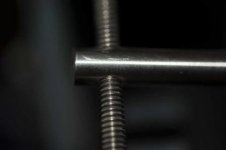rons
Diamond
- Joined
- Mar 5, 2009
- Location
- California, USA
A 3/8" stainless bar
1/4-20 GH3 coated tap
#7 cobalt drill bit.
When the tap is exiting the underside of the bar there are metal shards sticking out which is understandable.
I tried to wrap a collar around the bar but the finish on the bar gets damaged.
I know I could use a larger diameter bar and turn it down.
How do you get a clean threads on a curved surface.
1/4-20 GH3 coated tap
#7 cobalt drill bit.
When the tap is exiting the underside of the bar there are metal shards sticking out which is understandable.
I tried to wrap a collar around the bar but the finish on the bar gets damaged.
I know I could use a larger diameter bar and turn it down.
How do you get a clean threads on a curved surface.





